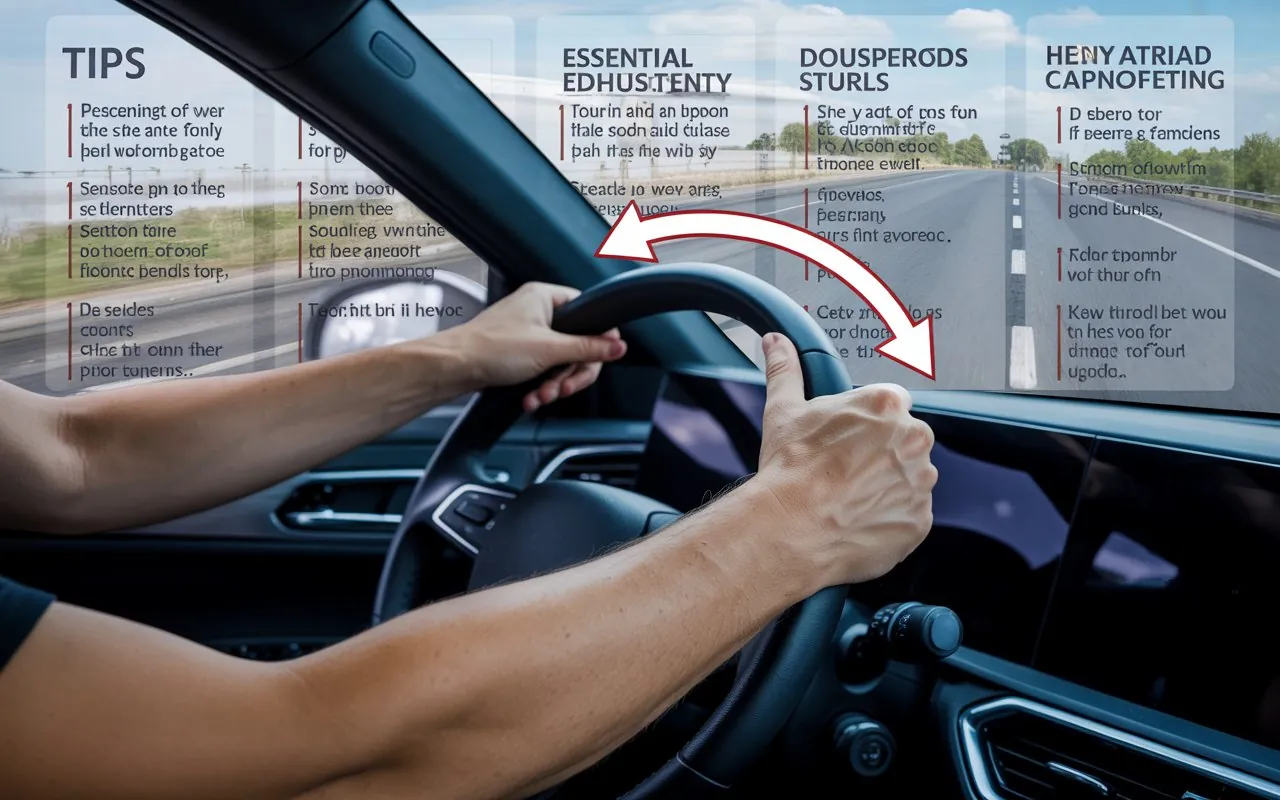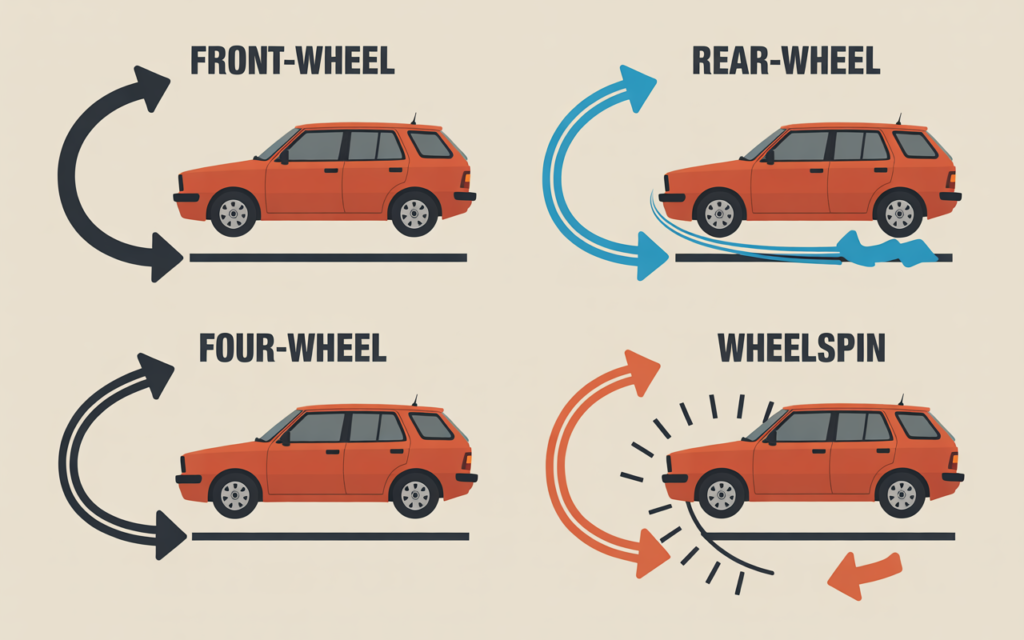Skidding is an unexpected, heart-stopping moment for any driver and can happen anywhere—whether you’re navigating the bustling streets of Lagos, winding through icy Nordic highways, or driving in monsoon-drenched cities around the globe. The reality is that no matter how careful or experienced you are, road surfaces can change in an instant due to rain, spilled oil, loose gravel, sand, or sudden weather shifts. This universal risk connects drivers everywhere in a shared challenge: how to regain control of your vehicle when the tires suddenly let go.
When recovering from a skid a driver should know exactly what actions to take within those critical seconds—not just to protect themselves and their passengers, but also everyone sharing the road with them. Yet, the moment a skid begins, instinct and panic often take over, leading to frantic moves that can make matters worse. That’s why mastering both the skills and the mindset for skid recovery is vital for safe driving, regardless of your vehicle, local climate, or driving culture.
In this comprehensive, hands-on guide, we deliver not only the step-by-step maneuvers essential for safe skid recovery, but also the science, psychology, and global perspectives that empower drivers of all backgrounds and experience levels. We’ll explore why skids happen, how to respond across different environments (from tropical rainfall to icy midnight roads), the impact of vehicle technology and maintenance, and the proven techniques recommended by top driving experts. Our goal is to move beyond generic advice, giving you the confidence, know-how, and real-world insight to turn a potentially dangerous loss of control into a safe, controlled return to the road.
Whether you’re a commuter, family driver, professional, or new behind the wheel, the information here is designed to build true confidence, helping you become a safer and more effective driver anywhere in the world.
The Science and Psychology of Skidding

What Happens When a Vehicle Skids?
A skid is a loss of traction between your tires and the road. This can result from a variety of actions, including sharp steering, abrupt braking, or rapid acceleration. Key factors influencing skid occurrence include:
- Road Surface: Wet, icy, sandy, or oil-slicked conditions dramatically reduce tire grip.
- Tire Condition: Worn, underinflated, or poorly maintained tires are prone to losing traction.
- Speed and Driving Maneuvers: High speeds, especially in corners, and rapid pedal inputs increase risk.
- Weight Distribution: The load in your vehicle (passengers, cargo) shifts weight, impacting control.
The Psychology: Panic vs. Preparedness
Panic is the number one enemy in a skid. The body’s natural fight-or-flight response may trigger abrupt, counterproductive reactions (such as slamming the brakes or yanking the wheel), increasing risk. Understanding the correct response transforms fear into effective action.
When Recovering From a Skid a Driver Should: Core Principles

Stay Calm Under Pressure
A key differentiator between safe recovery and accident is your state of mind. Remaining composed allows intentional, coordinated corrections rather than frantic, instinctive overcorrections.
Practice Staying Calm
- Take a deep breath when you sense a loss of control.
- Quickly assess your surroundings—space, traffic, obstacles.
- Visualize the recovery steps before making adjustments.
Reduce Throttle, Regain Traction
Immediately and smoothly take your foot off the accelerator. Removing power from the wheels helps return traction—your tires no longer have to juggle both speed and steering adjustments. This is universal advice, no matter your vehicle or where you drive.
Why Not Slam the Brakes?
Modern vehicles with ABS allow for firm, controlled braking—but for many vehicles and in most skids, abrupt braking increases the risk of locking tires, further reducing control. Light, progressive pedal input is preferred unless your vehicle specifically benefits from ABS in an emergency stop.
Steering: The Right Way vs. Common Myths
The “Steer Into the Skid” Confusion
The age-old adage “steer into the skid” is often misunderstood. The correct approach is to steer toward where you want the front of your car to go. For example:
- If the rear slides left, steer left to realign the car.
- If the rear slides right, steer right.
The key is gentle, measured inputs—not drastic turning.
Visual Focus
Look at your intended path, not the obstacle. The principle of “target fixation” means your hands will naturally steer toward where your eyes are looking. Train your gaze beyond the hood, down the road’s direction of safety.
Braking: Modern Technology Changes the Rules
For Non-ABS Vehicles
- Release the brakes if wheels have locked up.
- If braking is needed, use a gentle, pumping action to avoid lockup.
For ABS-Equipped Cars
- Press the brake pedal firmly and consistently.
- The ABS will pulse pressure automatically, letting you steer while braking.
- Don’t “pump” ABS brakes—this overrides the system and reduces its effectiveness.
Detailed Guide: Recovering From Different Types of Skids

Expanding on each major category of skids, here’s precisely what to do when recovering from a skid a driver should face. Practical, scenario-based advice ensures that, no matter your vehicle type or location, you’re fully equipped.
Front-Wheel Skid (Understeer)
Symptoms: The car refuses to turn, “plowing” straight ahead even while you steer.
Step-by-Step Recovery:
- Ease off the gas—stop accelerating to restore tire grip.
- Keep wheels pointed in your desired direction; avoid turning the wheel further as this can worsen the skid.
- Gradually regain steering as traction improves; you’ll feel the vehicle start to respond.
- Brake only if necessary and gently, especially if obstacles are ahead.
Practical Example:
Imagine you approach a roundabout too quickly during a rainstorm. The car refuses to follow your steering. Rather than yanking the wheel or slamming the brakes, lift off the accelerator, keep steering steadily, and as speed drops, the tires regain bite and you complete the turn safely.
Rear-Wheel Skid (Oversteer/Fishtail)
Symptoms: The back end of the car swings out, threatening to spin.
Step-by-Step Recovery:
- Stay calm and look where you want the car to go—not at the edge of the road or other vehicles.
- Gently steer in the direction you want the front wheels to go to regain alignment; do not abruptly overcorrect.
- Ease off the accelerator completely to reduce further rotational force.
- Avoid braking unless you are about to hit something; in which case, brake smoothly to minimize further loss of control.
Practical Example:
While accelerating through a corner on a wet urban street, the rear wheels slide outward. You glance quickly to where you want the car to point, steer slightly into that direction, and gently let off the gas. The car’s rear tires re-engage, and you continue safely.
Four-Wheel Skid (All Wheels Locked)
This typically happens under hard, abrupt braking, especially on slippery roads.
Step-by-Step Recovery:
- Release the brake pedal fully; let the wheels turn again.
- Steer in the direction of travel.
- Brake again gently, if needed.
- If your car has ABS: maintain firm, steady pressure on the brake.
- Without ABS: apply steady, light pressure to avoid another lock-up.
Practical Example:
A child dashes out in front of you on a rainy road; you slam the brakes, and the car begins to slide. Instinctively, you release the brake a moment, regain control by easing the wheel towards a clear lane, then reapply the brakes smoothly once you’re past the hazard.
Wheelspin Skid (Loss of Traction on Acceleration)
Usually happens when accelerating from a stop on a wet or loose surface.
Step-by-Step Recovery:
- Lift off the throttle until the wheels stop spinning.
- Apply gentle accelerator pressure as traction returns.
- If driving a manual, shift to a higher gear to reduce wheel torque and promote grip.
Practical Example:
You’re stopped at a red light during a tropical downpour. When the light changes, you press the pedal and the wheels spin uselessly. Instead of pushing harder, you lift off, wait for grip, and then move forward slowly.
Preventing Skids: Proactive Defensive Driving World Over

While knowing how to recover from a skid is vital, consistently practicing proactive, defensive driving reduces your chances of entering a skid in the first place.
Preparation and Mindfulness
- Observe Road Conditions Constantly: Scan for oily patches, standing water, fallen leaves, sand, or ice.
- Adjust Speed for Conditions: Slow down in poor weather or on questionable surfaces, even below posted limits.
- Extend Following Distance: Give yourself a larger margin to react to others; more space equals more time to correct.
Optimize Tire and Vehicle Maintenance
- Check Tire Pressure Weekly: Consult your vehicle manual for correct PSI.
- Rotate Tires Regularly: Maintains even wear and consistent grip.
- Examine Tread Depth: Replace tires when tread gets low—a common cause of hydroplaning.
Drive Smoothly
- Accelerate and Brake Gently: Abrupt pedal use is a primary skid trigger.
- Enter Corners at Sensible Speeds: Make adjustments before curves, not during.
- Stay Attuned to Vehicle Feedback: If you feel slight slipping or hear tire squeal, back off and recover gently; these “pre-skid cues” are valuable warnings.
How Environment and Geography Affect Skid Dynamics
Drivers in different parts of the world face unique challenges when it comes to skidding.
Tropical and Subtropical Regions (e.g., Lagos, Southeast Asia)
- Heavy, sudden rainfall: Raises risk of hydroplaning and disguised oil slicks.
- Muddy or clay roads: Rural areas may see “slip-and-slide” conditions during wet seasons.
- Urban surface run-off: In heavy traffic zones, compacted surfaces can get unexpectedly slick.
Temperate and Polar Regions (Canada, Scandinavia)
- Ice, Snow, and Black Ice: Regular winter hazards require specialized tires and techniques.
- Loose Gravel and Grit: Snow-melting efforts spread loose material, increasing slip risk.
Dry and Arid Areas (Middle East, Africa’s Sahel)
- Sand on Roads: Creates patchy, ultra-slippery conditions, similar to ice.
- Tire Dry Rot: Long sun exposure can degrade tire material, decreasing grip.
Adapt driving techniques and vehicle maintenance to local realities. For example, use all-weather or winter tires when necessary, and ensure windshield wipers are in top shape for frequent rainstorms.
Skid Recovery Tips For Different Vehicle Types

Front-Wheel Drive (FWD) Cars
- Generally more stable in oversteer, but can still experience severe understeer if pushed.
- Recovery Methods: Prioritize gentle lifting off the throttle and cautious steering.
Rear-Wheel Drive (RWD) Cars
- More susceptible to fishtailing and spinning if accelerating or turning too eagerly on slippery surfaces.
- Tip: Practice in safe environments to develop “throttle feathering”—reducing or modulating pedal input rapidly.
All-Wheel Drive (AWD) and Four-Wheel Drive (4×4)
- Improved resistance to skids overall, but no car is “skid proof.”
- When recovering from a skid a driver should use the same basic recovery steps; do not rely solely on mechanical grip.
Commercial and Heavy Vehicles
- Higher centre of gravity increases risk of rollovers in a slide.
- Longer stopping distances require increased vigilance in poor weather.
- Frequent checks on tire condition, brake balance, and load security are essential.
Skid Recovery and Road Safety: Impactful Real-World Case Studies
Urban Skid: Avoiding a Chain Collision
During rainy rush hour in Lagos, a driver hydroplanes while following too closely. Instead of panicking, they ease off the accelerator, gently steer forward, and avoid overcorrecting—preventing a pile-up behind them.
Rural Ice Skid: Defensive Brake Use
A professional driver in Northern Scandinavia locks up on black ice. Knowing their truck has ABS, they maintain steady brake pressure, steering toward a snowbank rather than oncoming traffic. Both maneuver and composure prevent major loss.
Mastering Skid Recovery: Practicing Skills Safely and Effectively

The muscle memory needed to recover from a skid is best developed under controlled conditions:
- Attending a Professional Driving Course: Many offer wet and dry skid pads for hands-on practice.
- Simulating Scenarios in Empty Parking Lots: Practice at slow speeds, with appropriate safety measures in place.
- Using Simulators and VR Training: Increasingly, advanced technology lets drivers experience and learn from virtual “skids.”
Practice Tips:
- Replicate typical skids associated with your region’s weather and road surfaces.
- Practice recovering from both entry and recovery phases of understeer and oversteer.
- Teach family members, especially new drivers, to recognize and correct skids.
When Recovering From a Skid a Driver Should: Common Mistakes and Myths
Mistakes to Avoid
- Slamming Brakes Reflexively: Instinct may be to brake hard, but this often locks the wheels.
- Overcorrecting Steering: Quick, forceful wheel movements may transform a skid into a spin.
- Ignoring Tire Wear and Pressure: A leading cause of skidding is neglecting basic tire care.
Myths Dispelled
- “ABS makes you skid-proof.”
ABS helps with braking and steering during a skid, but cannot overcome total loss of friction. - “Only icy roads cause skids.”
Oil, water, sand, and even leaves or rubber debris can trigger skids worldwide.
Advanced Skid Control: Handling High-Risk Situations
The best drivers go further than just knowing when recovering from a skid a driver should take action—they anticipate and avoid the riskiest scenarios.
Hydroplaning
- What it is: Tires ride on a film of water, eliminating direct contact with the road.
- How to recover: Lift off the accelerator, don’t steer or brake abruptly, and wait for the tires to reconnect.
Black Ice and Invisible Hazards
- Drive extra slowly and never use cruise control.
- Any unexplained sense of “floatiness” may indicate a slippery patch.
Skid Recovery at High Speeds
- Small, measured steering and pedal inputs are more important; dramatic movements can quickly result in loss of control.
Technology, Tires, and Traction: How Modern Advances Influence Skid Events
Advanced Driver-Assistance Systems (ADAS)
- Traction Control: Automatically reduces engine power if excessive wheelspin is detected, helping prevent some skids.
- Electronic Stability Control (ESC): Detects and assists in correcting skids with targeted braking on individual wheels.
Specialty Tires
- Winter Tires: Formulated for better performance in cold and icy conditions.
- All-Season Tires: Balanced for mixed conditions but less effective than dedicated options.
Tire Pressure Monitoring Systems (TPMS)
- Warn drivers of under- or over-inflated tires that could compromise grip.
Expert Advice and Global Best Practices
- Practice makes perfect: Take time for real-world or simulated skid recovery drills.
- Adapt to local hazards: Research road and weather challenges unique to your area.
- Educate your household: Make skid-recognition and corrective steering part of family driver safety culture.
Frequently Asked Questions

Q: Should I always “turn into the skid” no matter what?
No—focus on steering where you want to go, aligning your front tires with your intended path.
Q: Can cruise control worsen skidding?
Yes. On slippery roads, cruise control can accelerate the car when traction is lost. Always turn it off in poor weather.
Q: Is it possible to completely prevent skids?
While you can reduce the risk significantly, certain conditions (unpredictable black ice, sudden oil spills) can make skidding inevitable at times.
Q: How often should I check my tires?
At least weekly for inflation; monthly for tread depth and sidewall condition.
Conclusion
When recovering from a skid a driver should keep calm, act deliberately, and understand the why behind the how. Skid handling is a universal driving skill, bridging technology, psychology, geography, and personal responsibility. With advanced preparation, ongoing practice, and the right mindset, you’ll not only boost your confidence—you’ll help keep everyone on the road safer, no matter where you steer.